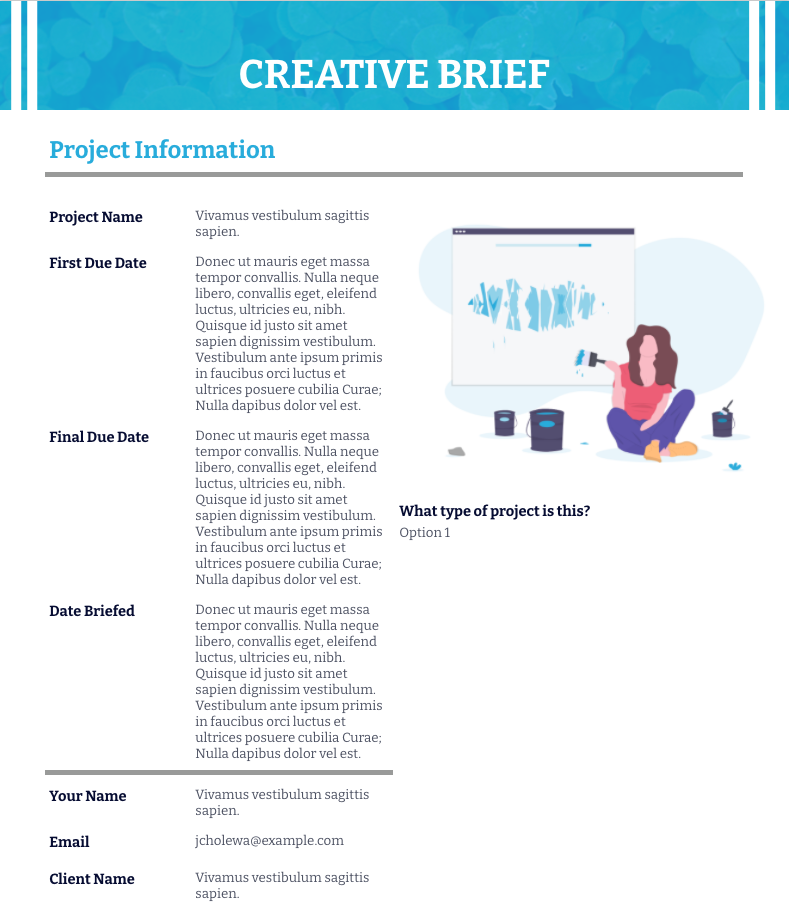Every creative marketing project should start with a structured outline of the project’s objectives, messaging, and audience. From branding to social media and email to content marketing, every aspect of a marketing campaign can benefit from a strategic and carefully documented creative brief.
If you’re new to marketing — or if you’re handling the process as part of your startup rather than employing a creative team — you may not be familiar with how to write a creative brief. This article explains what marketing teams should include in a brief and offers practical tips for writing each section. This is important, since campaigns are important parts of broader marketing plans.
Defining a great creative brief
The best brief is a short, detailed guide that a creative project manager, marketing department, or creative agency can use to lead them through the creative process. The brief also helps you communicate with a client to ensure the project’s goals, intended audience, and messaging meet expectations. Additionally, if you hire a freelance copywriter or graphic designer, the document serves as a roadmap for their work.
A creative brief should be succinct — a few pages is sufficient — but detailed enough so that everyone understands the project goals and deliverables.
Getting started
Before you write a word, first speak to the project stakeholders and get the relevant background information. This information helps you understand what they want to accomplish with a specific ad, social media campaign, or marketing project.
Get a list of what’s important to stakeholders or clients as well as the key messages they want to get across to their audience. Also, verify the intended audience segments and ask the stakeholders to share their value proposition for those targets.
Benchmark creative brief examples
One of the best ways to produce a professional briefing document is to look at examples of good creative briefs. Jotform provides a free creative brief template that you can use to reduce the amount of time you spend on formatting and ensure your document has a polished look.
Begin with the background and context
The background section is the starting point for your creative brief. It sets the tone and context, and should consist of a few brief sentences. This is where you specify the mission and goals associated with the creative project.
You can distinguish this section from the others by adding a heading — such as “Background” or “Brand Statement.”
Define objectives
The next section should address the objectives that will guide the creative work and explain the overall project needs. An effective creative brief quantitatively and qualitatively describes the intent of the project in order to inform the internal team about what they need to accomplish.
Describe the target audience
To create an engaging social media campaign, ad, blog post, or email message, you have to know what interests your audience. In this section, define the audience segments.
These details should include basic demographic information, such as age, gender, and geographic location. However, you’ll need to delve deeper, adding factors like customer pain points and motivations. If your team or client already has a buyer persona, include a summary of this information here.
Address the competitive landscape
As part of the context for a specific creative approach, include a section describing the competition, including what your competitors are doing, what has worked for them, and what has failed or underperformed.
The competitor analysis process will help you lay the foundation for the approach you plan to take with your creative project. Focus on differentiating your brand and project while aligning all activities with your brand’s value proposition.
Outline the plan of action
A key aspect of the creative brief involves listing where the target audience will see the campaign. Include information about the campaign messages and format as well as the intended channels or platforms.
The promotional strategy should reflect where your target audience spends their time. For example, if your audience includes Millennials and Gen Z adults, list the platforms where your targeted prospects already participate — such as Instagram, Snapchat, and TikTok.
Get feedback
Once you have a draft of your creative brief, seek feedback from others — such as the rest of your team, other stakeholders, or your client. Circulate the brief as a draft to elicit ideas, recommended changes, and additional content to ensure that it captures the campaign’s purpose and goals. Collaboration helps build a successful creative brief because it unifies efforts to deliver a high-performing campaign, one that provides a positive return on the marketing investment and achieves the campaign’s strategic goals.

































Send Comment: